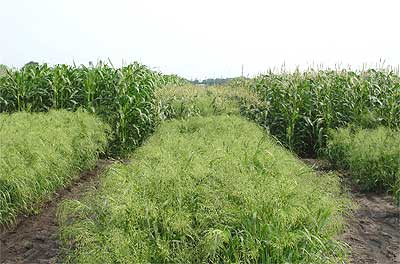Urbana, Illinois
June 30, 2005
It makes sense that if weeds can't get a lot of
sun, they won't be able to grow as well. Marty Williams, an
ecologist with USDA's
Agricultural Research Service in the College of
Agricultural, Consumer and Environmental Sciences at the
University of Illinois, used
this premise as he began his search for sweet corn hybrids that
have the ability to naturally suppress weeds.
"There aren't a lot of tools for weed management in sweet corn,
so I decided to look at the inherent characteristics in
different hybrids that might help reduce some weeds naturally,"
Williams said. "Using a more competitive hybrid -- one that
naturally suppresses weeds - means farmers can use less
herbicide and get more consistent crop yields."
|
 |
| Test plots
from 2004 show in the foreground wild proso millet and
the dramatic difference in the canopies of three sweet
corn hybrids in the background: GH2547, left; Spirit,
center; WH2801, right. |
For his study, Williams chose three commercially
available sweet corn hybrids that have different canopies in
order to determine how the density of the canopy might affect
weed growth. He chose Spirit, WH2801 and GH2547. "Unfortunately,
it's not practical to do this study for every hybrid. There are
just too many," said Williams. "But what we hope to do is
eventually get enough information to classify hybrids as
competitive or not competitive in weeds."
Wild pros millet was grown at low, medium, and high weed
densities within the sweet corn hybrids. This particular weed
was chosen because it is one of the fastest-spreading annual
grass weeds in the cornbelt and it's a significant problem
because few herbicides are effective against it in sweet corn.
Last year's results showed that Spirit, a hybrid with little
canopy, had a 70 percent yield loss at high weed pressure. It
didn't tolerate weeds very well at all. WH2801, which was
taller, faired better in its ability to suppress weeds while
maintaining a high yield. GH2547, which had the largest canopy,
did even better at both. "And, since it managed to suppress weed
seed production better, there would be fewer weeds emerging next
year in that field," said Williams.
The same experiment is being conducted now to see if the results
are consistent under drier conditions observed this year.
In Illinois, processed sweet corn sold in cans or frozen in bags
or on the cob is a significant commodity. Illinois, Wisconsin
and Minnesota supply about half of the sweet corn for processing
in the United States. Washington State provides the other half.
Rick Boydston, with USDA-ARS at Prosser, Washington is
duplicating Williams' canopy experiment. "The results from Dr.
Boydston's first year were similar but not as dramatic as ours
here in Illinois. Any differences in the ability of hybrids to
suppress weeds are important, since every bit helps," said
Williams.
This study is focusing on yield and weed suppression, but yield
isn't the only consideration. What about the sweet corn sugar
content, taste, and appearance? In another one of Williams'
research projects, he is looking at about a dozen different
quality traits and determining how they are affected by the
weeds. "For example, the number of ears is important for fresh
market sweet corn - what you find in the produce aisle - whereas
kernel weight is extremely important for sweet corn grown for
processing - what you buy in the can," said Williams. "Since
eradicating every weed in sweet corn is impractical, we need to
know exactly how weeds - particularly at low densities -
influence these traits."
Author: Debra Levey Larson |